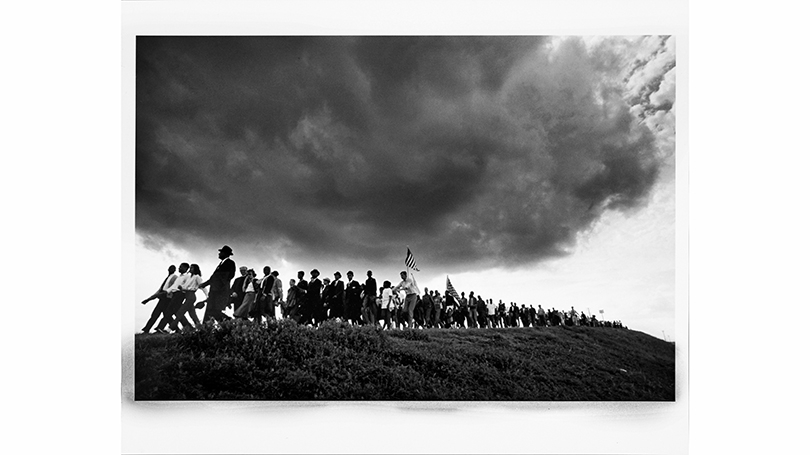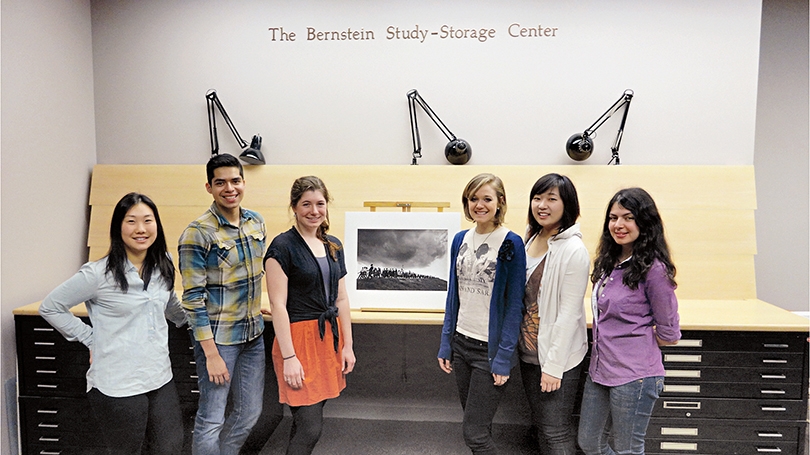Hood Quarterly, autumn 2014
Amelia Kahl, Coordinator of Academic Programming
I was drawn to that specific image because the Hood's collection includes many civil rights-era pieces, but few of them actually illustrate what civil rights activism looked like. Karales's photo, with other Karales photos in the series, provides a context for the rest of the Hood's civil rights collection. Since our group had the opportunity to visit the galleries from which we were evaluating photographs, I'm happy to say that the Greenberg Gallery's dedication to the discipline of photography and educational approach influenced my decision to support them.
—Matt Storm '13
This year, six Dartmouth students and one recent graduate traveled to New York City with Katherine Hart, Senior Curator of Collections and Barbara C. and Harvey P. Hood 1918 Curator of Academic Programming, and Amelia Kahl, Coordinator of Academic Programming. Their assignment was to choose a work for the Hood's collection, the culminating activity of Museum Collecting 101, a non-curricular course taught at Dartmouth every year. After visiting three galleries and engaging in careful deliberation and debate, they selected James Karales's photograph Selma-to-Montgomery March for Voting Rights in 1965, which documents a key moment in the civil rights movement.
Iris Yu, Class of 2014, writes, "I was originally drawn to the Karales because of the beauty of the print, and the magnificent clouds above the marchers in the image. However, what drew me to the print as the selection was the combination of the striking image and the strong historical significance. The image has such importance and documents the spirit symbolism."
Through this course, which the Hood has offered annually since 2002, the museum has acquired a diverse and important group of works chosen by Dartmouth students. In the program's first year, the group traveled to Boston to visit photography dealers, but since then students have worked from digital images, often not seeing the chosen work of art in person until after the purchase. This year, through the generosity of Andrew Lewin, Dartmouth Class of 1981, the group traveled to New York to visit photography galleries, learn from dealers about the artists, and view the works under consideration. The students also had the opportunity to visit with noted private collectors Mary Ann and Frank Arisman, and spoke with Frank about his own personal journey to becoming a collector of photography. During the final morning of the trip, the group toured the exhibition What is a Photograph with curator Carolyn Squiers at the International Center of Photography. The class prepared for the trip with several visits to the Hood Museum of Art in the weeks prior. They learned about the Hood's acquisition policy and viewed photographs selected by earlier groups of Museum Collecting 101 students. They also explored the breadth and depth of the Hood's photography holdings to gain a greater sense of how a new work would fit into the collection.
In their third meeting, photographer and recent graduate Matt Storm '13 gave a hands-on session on photography techniques. Students worked in the Black Family Visual Arts Center's darkroom and computer lab to experience traditional and digital photography. In the final pre-trip meeting, students previewed the artists and photographs they would see. Works under consideration included abstract photos by Marco Breuer, self-portraiture by Vivian Maier, and historical documentation of the by- standers during Robert F. Kennedy's funeral train procession Paul Fusco, among others.
After seeing the photographs in New York, the group focused their attention on James Karales's work documenting the civil rights movement and the small town of Rendville, Ohio, during the 1950s and 60s. Due to the students' interest, the Hood also purchased two additional photographs: one, by Paul Fusco, of a Baltimore crowd viewing Robert Kennedy's funeral train, and another, by Tim Heatherington, of an American soldier stationed in Afghanistan.
Museum Collecting 101 is a rich and vibrant program that has allowed undergraduate students to leave a legacy that extends far beyond their four years on campus. The works they have chosen over the years are frequently used for teaching and exhibitions and the objects' credit lines bear the names of the students who chose them. This year's selection, Selma-to-Montgomery March for Voting Rights in 1965, has particular resonance with our fall exhibition Witness: Art and Civil Rights in the Sixties.
Related Stories
- Spring 2016 Museum Collecting 101 (July 2016)
- Dartmouth Now, "Dartmouth Students Learn 'Museum Collecting 101' at Hood Museum of Art"
- A Focus of Student Impact: Museum Collecting 101 (summer 2012)
- Dartmouth Students Learn "Museum Collecting 101" at Hood Museum of Art (May 2011)
- Community of Learners: Museum Collecting 101 (spring/summer 2010)
- Dartmouth Students Make an Acquisition (summer 2004)

